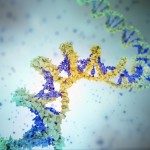Link to Pubmed [PMID] – 10791758
Int. J. Food Microbiol. 2000 Apr;55(1-3):281-4
Despite the numerous advantages of fluorescent in situ hybridization (FISH) for identifying a single bacterial cell with 16S rRNA probes, problems are encountered with starving bacteria in natural samples. The original direct viable count procedure (DVC) includes a revivification step in the presence of an antibiotic inhibiting cell division. Cells elongate and accumulate ribosomes. This results in a natural amplification of 16S rRNA molecules (target of FISH). However, it is limited to gram-negative bacteria which are sensitive to nalidixic acid. The objective of this study was to develop a procedure for estimating the number of metabolically active gram-positive Staphylococcus aureus and Enterococcus faecalis cells by the use of a method which combines the number of substrate-responsive cells and their identification by FISH. It was observed that no single published DVC method could apply to taxonomically different gram-positive bacteria. Since cells were not counted, the revivification step in presence of nalidixic acid will be referred to as revivification without cell division. For each species, different low-nutrient media and complex media, different fluoroquinolones and beta-lactam antibiotics, concentrations of antibiotics, combinations of antibiotics, temperature and time were evaluated using bacteria in different physiological states and in natural samples. Enumeration of bacteria by plate counts and direct FISH were compared. The improved procedure should yield information about the physiological state, the taxonomic identity, and the enumeration of viable gram-positive bacteria. The application of DVC to an entire ecosystem is presently still a challenge.

